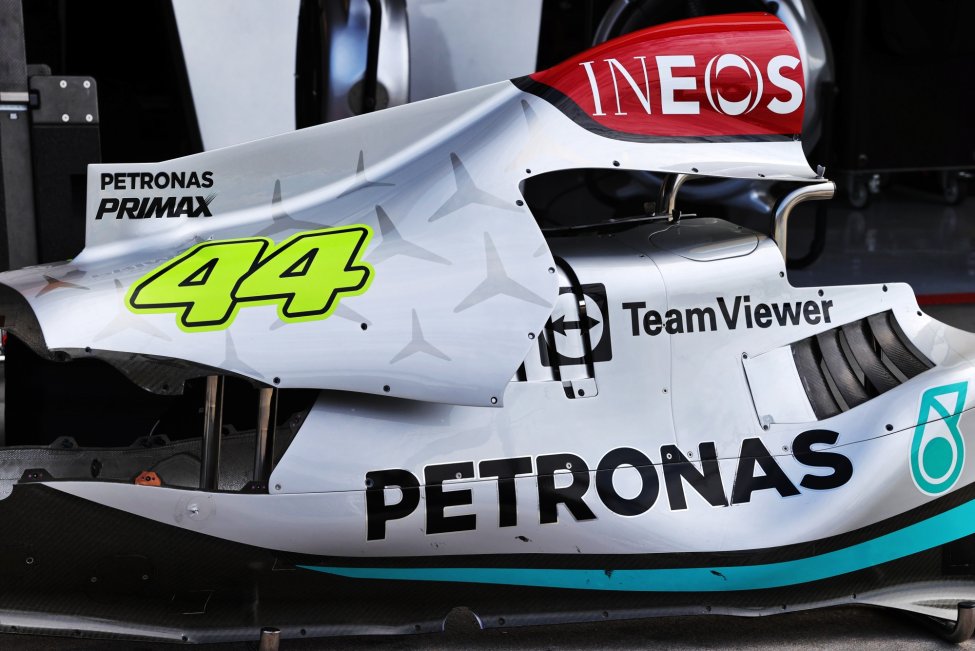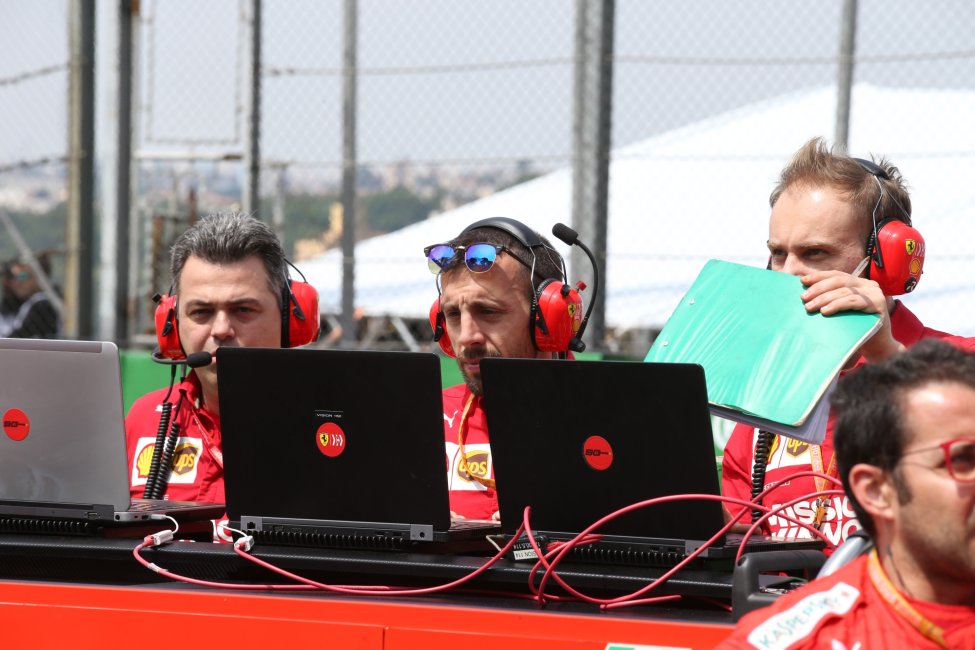Formula 1 Technology
What are sidepods, how does DRS work and what are all those buttons on an F1 steering wheel for? This page will answer all your technical F1 questions!

Engine F1-car
A Power Unit, an MGU-H, an MGU-H, Turbo and so on.... Today's engine of a Formula 1 car is more complicated than ever before. On this page, we explain to you from head to toe how an F1 engine is put together!
Drag Reduction System (DRS)
"He has DRS now!" or, "He's almost in Hamiltons' DRS'" are phrases that may seem familiar to you. The Drag Reduction System made its appearance in Formula 1 in 2011 to increase the amount of overtaking opportunities. Drag Reducation System literally means drag reduction system. When DRS is deployed, the rear wing of an F1 car opens which results in less drag being generated here. This results in more top speed and increases the chances of successful overtaking. On this page you can read all about the system.
Sidepods F1
Sidepods are an important part of an F1 car's aerodynamics. They are integrated on the sides of the cockpit and play a crucial role in generating downward pressure and optimizing airflow over and along the car. This results in better grip and stability during racing.
What are sidepods F1?
The sidepods are also important for cooling the engine and other components of the car, such as the brakes and gearbox. This allows the engine to run at maximum performance and minimizes the risk of overheating. In addition, a side pod contains crash structures that absorb forces in the event of an accident.
Over the years, sidepods have evolved considerably, taking on different shapes, from small round wings to large, streamlined boxes. Teams invest a lot of time and money in designing and optimizing their sidepods to get the most out of the car.
Sidepods Mercedes F1
With the arrival of new regulations in 2022, the current generation of F1 cars came to look very different. Among other things, this made Formula 1 teams experiment creatively with the design of the sidepods. The most striking concept is that of Mercedes' team. When Mercedes presented its W13 car in 2022, it looked like there were no sidepods on the car at all. In 2023, the Brackley-based racing stable refined this concept. Read more on this topic here.
F1 steering wheel
During the first Formula 1 races, the Formula 1 steering wheel had only one purpose - steering. Today, the F1 wheel is a lot more complex. What can a Formula 1 driver do with the wheel and what do all those buttons mean? Read more about the Formula 1 steering wheel here.
Halo F1
It is impossible to imagine Formula 1 these days without the halo and it has already saved several lives of F1 drivers. What exactly is a halo and what is it for? You can read all about it on this page.
Aerodynamics F1
Aerodynamics is critical in Formula 1. Optimizing airflow around the car helps reduce drag and generate downforce. This improves stability, traction and cornering speeds, which is essential for success on the track. Mastering aerodynamics is an ongoing challenge in the quest for competitive advantage. Read all about how F1 car aerodynamics work here.
Formula 1 brake systems
An F1 car's brakes are made of carbon fiber, a lightweight material that is highly resistant to heat and wear. This allows the brakes to work very efficiently, even at high temperatures. The brake pads are made of ceramic material and are specially designed to heat up quickly and respond to the driver's pedal input.
An F1 car can go from 200 mph to a stop in less than 100 meters. In addition to the ability to slow down quickly, an F1 car's brakes must also be able to perform under extreme conditions. During the race, the brakes can reach temperatures in excess of 1,000 degrees Celsius, posing a huge challenge to the brakes and braking material. Therefore, during the race, the brakes are constantly monitored and adjusted to ensure they remain at optimal temperatures.
Because brakes play such an important role in the performance of an F1 car, much time is spent optimizing the brake material and the brakes themselves. Brake manufacturers are constantly developing new technologies to improve brake performance while saving weight to improve the overall performance of the car.
Generating energy with braking
Through the Energy Recovery System (ERS), a Formula 1 car generates energy during braking. When the driver brakes, the braking forces are converted to electrical energy. Read more about the this process here.
Speed trap F1
What is the top speed of a Formula 1 car and what exactly is a speed trap? Find out on this page.
Tires F1 2023
Although to the outside eye there appear to be only three types of slicks (dry-weather tires) within Formula 1, this is not the case. Pirelli provides six types of slicks. These are characterized from C0 to C6. The higher the number after the C, the softer the tire. In short: the C0 is the hardest compound the Italian tire supplier has to offer, the C6 the softest.
Tire colors F1
Before a Grand Prix weekend, Pirelli makes a choice in which tires to use. Sometimes these include the C2, C3 and C4. In this case, the C2 gets a white color (hard), the C3 a yellow color (medium) and the C4 a red lick of paint (soft). It may be that other compounds are used the following weekend, for example, the C0 through C2. In that case, the C0 will be the hard tire, the C1 the medium and the C2 the soft tire. Even then, the three different types of tires are characterized by a color.
So the color indicates how hard or soft a tire is. Below you can read what effect the softness of a tire has.
- Red tire: is the softest and offers the most grip. However, this tire also wears out the fastest. This type is mostly used in qualifying.
- Yellow tire: also called the medium. The name says it all, this tire is in between the red and the white tire. The yellow tire has medium speed and wear and is used almost every race.
- White tire: this is the hardest of the trio. This one has the longest life cycle of the bunch.
Rain tires F1 | Full Wets & Intermediates
Formula 1 drivers also compete in wet conditions. Because dry weather tires (slicks) do not contain tread, F1 drives with special rain tires in bad weather. Rain tires are available at all times. In light to mild rain, intermediates are fitted to the car. These have a green color. In heavy rain they use Full Wets. These tires can shed more water than the intermediates, but have a lower grip level. That makes the Full Wets the slower compound of the two.
Tire warmers F1
A Formula 1 car performs at its best when the tires are at the right temperature (window). The tires of an F1 car rise in temperature when driven. For this reason, Formula 1 uses a warm-up lap (formation lap). Teams use tire warmers prior to a session or pit stop to bring the tires (partially) up to temperature. Tires may be preheated to 50 degrees Celsius in 2023. In addition, teams may use up to twenty tire warmers.
How big is an F1 tire?
Pirelli F1 tires are 18 inches in diameter.
How much does an F1 tire weigh?
A tire on a Formula One car weighs between 9.5 and 11.5 kilograms.
F1 Data
How do Formula 1 teams use data to improve car performance? Data is a very important component in Formula One. By collecting that data and analyzing it, the performance of the car and driver can be optimized. Data also plays a big role in determining strategy and can give a lot of information about the car during a Grand Prix, for example. There are more than 200 sensors on a Formula 1 car that collect information about the engine, brakes and tires, for example.
Also, Formula 1 drivers often get to see data on a screen when they are in the car in the paddock of their past laps, for example. This also allows Formula 1 drivers themselves to see where, for example, they are leaving it relative to their teammate.
Detecting a small detail in the data, can make a big difference.
Don't miss out on any of the Formula 1 action thanks to this handy 2026 F1 calendar that can be easily loaded into your smartphone or PC.
Download the calender

















